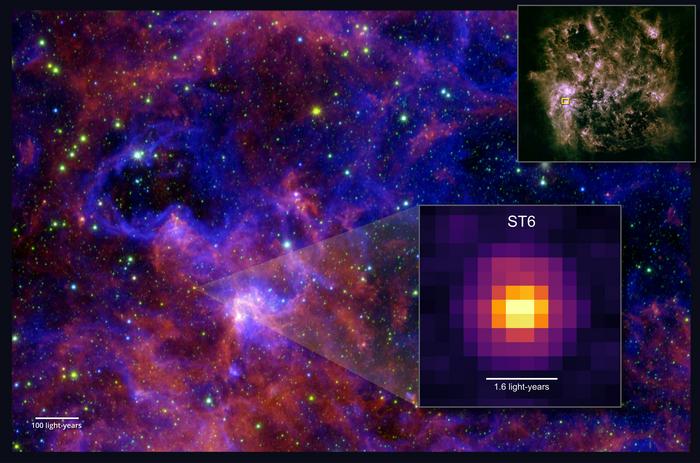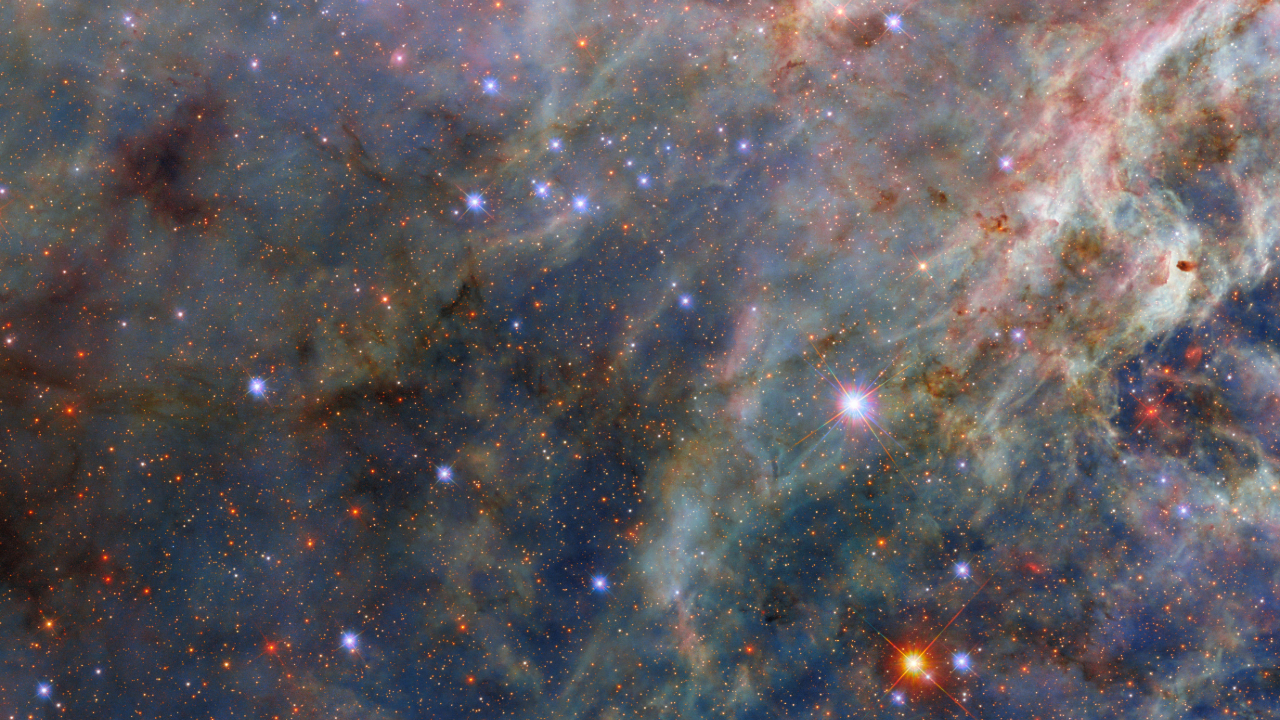JWST makes key detection of complex organic molecules around star in galaxy beyond our Milky Way
The molecules are building blocks of the chemical precursors of things such as RNA.

Frozen complex organic molecules have been discovered for the first time as ices around a young protostar in a galaxy other than our own, thanks to the observing power of the James Webb Space Telescope (JWST).
Astronomers led by Marta Sewiło of the University of Maryland used the JWST's Mid-Infrared Instrument (MIRI) to detect myriad complex organic molecules (COMs) in ice that encase grains of dust around the massive protostar ST6 in the Large Magellanic Cloud (LMC), which is a neighboring dwarf galaxy about 163,000 light years away. COMs are classed as carbon-bearing molecules containing more than six atoms, and many COMs are the chemical precursors to the building blocks of life as we know it.
The frozen COMs that were confirmed to exist around ST6 include acetaldehyde, acetic acid, ethanol, methanol and methyl formate. On Earth, methyl formate and acetaldehyde are used as industrial chemicals, methanol and ethanol are alcohols, and acetic acid is in vinegar. But they are also the backbone of even more complex, "second-generation" molecules that build the likes of amino acids and RNA molecules.
At least 14 other absorption lines were also detected by JWST, but so far Sewiło and her colleagues have been unable to confirm their identity.
"We have only just started exploring the dependence of complex organic chemistry on the environment," Sewiło told Space.com in an interview.
JWST is breaking new ground in the study of chemistry in environments where stars and, later, planets form.
Stars form when massive clouds of frigid molecular gas begin to fragment and collapse, producing dense cores where stars begin to coalesce. At first, these cores are cold, less than 100 kelvin (i.e., 100 degrees above absolute zero) and complex molecules exist as ices on dust grains. It is only later, when the core grows hotter, that the ice sublimates and releases the COMs as gases.
Breaking space news, the latest updates on rocket launches, skywatching events and more!
Whereas COMs in their gas phase have been detected multiple times around young stars in both the Milky Way galaxy and the LMC — for example, both methanol and methyl formate had previously been found in their gas phase around protostars in the LMC — they have been far harder to spot when in the earlier, cold ice phase.
"JWST has enabled the detection of COM ices, but to date there are only four protostars in the Milky Way where we have detected icy COMs, and only one in the LMC — ST6," said Sewiło.
By detecting the COMs in their frozen states, astronomers get an indication of how far evolved the chemistry of the material surrounding protostars is at the earliest stages of star formation.
Their presence around a young, massive protostar in the LMC is also intriguing, given the differing conditions there compared to our Milky Way galaxy. The LMC has properties in common with galaxies that existed when the universe was much younger, namely a lower abundance of elements heavier than hydrogen and helium and a stronger ultraviolet radiation field. The lack of heavy elements could impact the abundance of COMs, while the ultraviolet radiation could affect the rate of chemical reactions.
Therefore, understanding the organic chemistry of the LMC can also help teach us about the organic chemistry of the early universe, in particular how soon the building blocks of life were able to form. This could help place limits on how early, theoretically, life could have formed in the universe.
The dearth of heavy elements in the LMC does seem to have impacted the abundance of COMs around ST6.
"The COM ice abundances with respect to water ice that we measured for ST6 are lower than those measured for the four protostars in the Milky Way for all COMs, as expected, except for acetic acid," said Sewiło. "The overabundance of acetic-acid ice is likely the result of the higher ultraviolet flux in the LMC."
Among the unknown absorption lines in ST6's spectrum could be glycolaldehyde, which is a chemical precursor to ribose, which is a component of RNA molecules.
"We have found evidence that several of the unidentified absorption features could be attributed to glycolaldehyde, but the detection remains inconclusive since more laboratory spectra are needed to verify it," said Sewiło, alluding to the fact that the star's spectrum is compared to those of different molecules taken in laboratory conditions to identify which absorption lines belong to which COMs.
"It is likely that more COMs are present in the ices around ST6, and our results highlight the need for more laboratory experiments."
As the protostar evolves and heats up, the ice on the dust grains nearest the star will sublimate and the COMs will move into their gas phase, as has previously been detected.
It is in the gas phase that more chemical reactions can take place, triggered by ultraviolet radiation from the protostar and the wider environment, "leading to larger and more complex molecules important for life such as propanol and propanal, and possibly amino acids, but we've not detected them in ST6 yet," said Sewiło.
Amino acids have, however, been found in comets and meteorites in our solar system. Comets and meteorites are ancient bodies, formed 4.5 billion years ago when our sun was a protostar. The implication is that amino acids are the end result of a pathway of chemical reactions that begin with the kinds of COMs discovered around ST6.
The research was published on Oct. 20 in Astrophysical Journal Letters.
Correction 11/10: COMs have been seen in other galaxies before — this is the first time they've been detected as ices. The absorption lines referred to in the article may also not necessarily indicate 14 different molecules. This article has been updated to reflect that.

Keith Cooper is a freelance science journalist and editor in the United Kingdom, and has a degree in physics and astrophysics from the University of Manchester. He's the author of "The Contact Paradox: Challenging Our Assumptions in the Search for Extraterrestrial Intelligence" (Bloomsbury Sigma, 2020) and has written articles on astronomy, space, physics and astrobiology for a multitude of magazines and websites.
You must confirm your public display name before commenting
Please logout and then login again, you will then be prompted to enter your display name.

